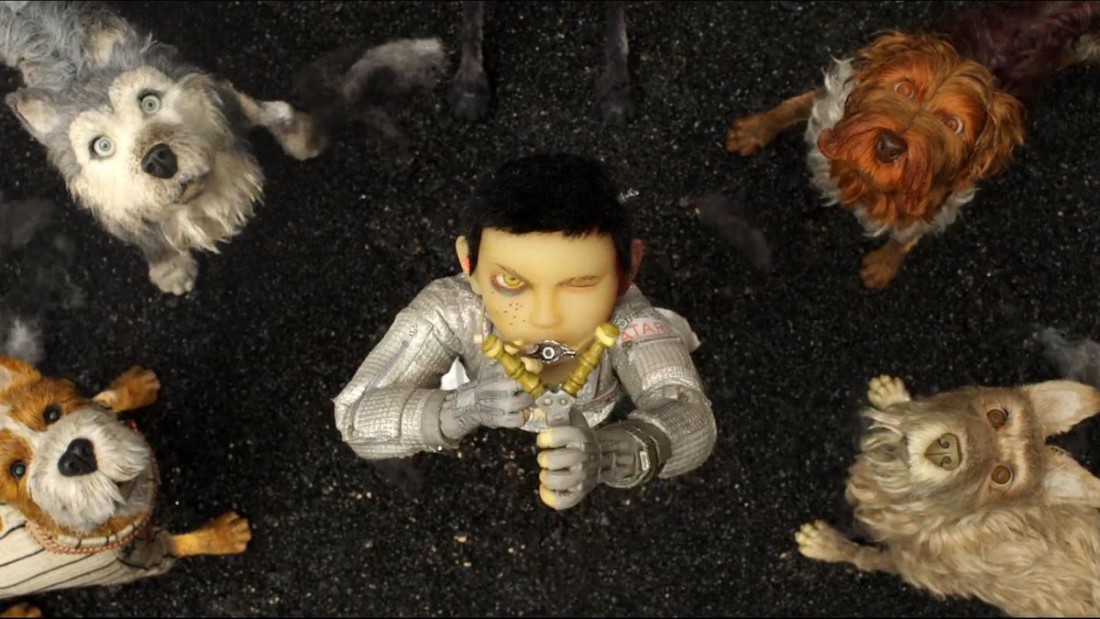Love him or hate him, writer/director Wes Anderson is something of a known quantity at this point. His auteurial signature — one of the most distinct and well-defined of any contemporary filmmaker — is effectively unmistakable, to the extent that the director’s name has almost become a genre in and of itself. But those who think that means they know what to expect from Isle of Dogs may be sorely disappointed, as Anderson’s latest finds him functioning in a different mode and addressing some new themes. At its core, Isle of Dogs is every inch an Anderson picture, with everything that implies, but there’s something else at play here as well that places Isle in somewhat uncharted territory within the context of Anderson’s oeuvre.
Set in a dystopian future Japan, Isle follows the journey of a young orphan (Koyu Rankin) on a quest to reunite with his beloved dog Spots (Liev Schrieber), exiled along with all the country’s canines to a desolate trash heap in the midst of a dog flu epidemic that threatens to jump the species divide and infect humans. Anderson is taking direct aim at the immigration and refugee crises confronting the U.S. and Western Europe, but his newly discovered political bent probes surprisingly deeper than the superficial liberalism that the premise would suggest. Isle deals with corruption and ulterior motives in the legislative process in a way that is remarkably mature, a depth belied by the film’s meticulous stop-motion animation. It may look like a kids movie, but this is Anderson’s anti-authoritarian streak at potentially its most unrestrained (sorry, no leash jokes here).
If the overt politicization of Anderson’s work is largely uncharacteristic, its style and execution are not. Those familiar with The Fantastic Mr. Fox will recognize the director’s animated aesthetic, but in many ways, Isle is more visually ambitious than Anderson’s prior foray into stop-motion. He cribs heavily from Akira Kurosawa and Yasujirō Ozu — with a touch of Kenji Mizoguchi thrown in for good measure — but the director’s trademark symmetrical compositions and long tracking shots create an aggregate effect predominantly unique unto itself. As one might expect, the cast assembled is an unparalleled ensemble of A-list talent too lengthy to recount in its totality, but the central players, including Bryan Cranston, Edward Norton, Bill Murray, Jeff Goldblum, Bob Balaban, Greta Gerwig and Scarlett Johansson, are all in peak form, and brief cameos from the likes of Harvey Keitel, Tilda Swinton and Frances McDormand threaten to turn the entire movie into a vocal Easter egg hunt. It’s the sort of thing that could only be accomplished by a beloved figure with a deep Rolodex, and it’s hard to imagine anyone other than Anderson pulling it off.
Is Isle of Dogs the best Wes Anderson movie? Absolutely not. But it’s as affecting as any of his works and seems to have more on its mind than the quirk and sentiment that have defined the majority of his output. As a step in a new direction, Isle is a collection of bold choices from a director who’s never been known to avoid risk, and the returns on the chances taken are deceptively substantial, given the positioning of Isle as what ostensibly amounts to a family film. While I doubt this indicates a new trajectory for Anderson’s career, I wouldn’t be the slightest bit disappointed to see more socially grounded films along these lines coming from him in the future. Rated PG-13 for thematic elements and some violent images. Now Playing at Fine Arts Theatre.








I was looking forward to this film — hey, it’s a Wes Anderson film! — but I hesitated to see it until today because of some very negative reviews (like RogerEbert.com) from people complaining about its lack of sensitivity to Japanese people. They can’t get past the lack of translation (actually, MOST is translated), or the mushroom cloud explosion, or how Tracy is the “white savior”, or how its depiction of Japanese culture is skewed. Well, of course, it’s skewed — it’s an allegory — it’s more about corruption of power and fear of foreigners and how politicians try to destroy faith in science for their own profit. If anything, I thought I was seeing a warped reflection of our own culture. Sure, it has a fascinating mid-1960s Japanese look superficially, but it’s not really about Japan at all , if someone cared to dig deeper. Your review was one of the very few that noted this aspect of the film and I thank you for that.
wes SSDD
so over him…fell asleep in the theater…. movie blew